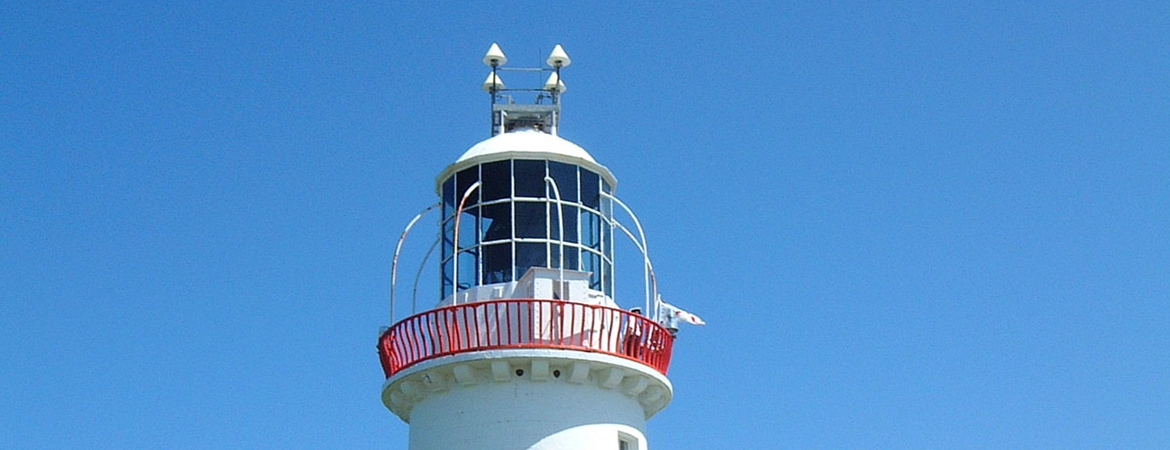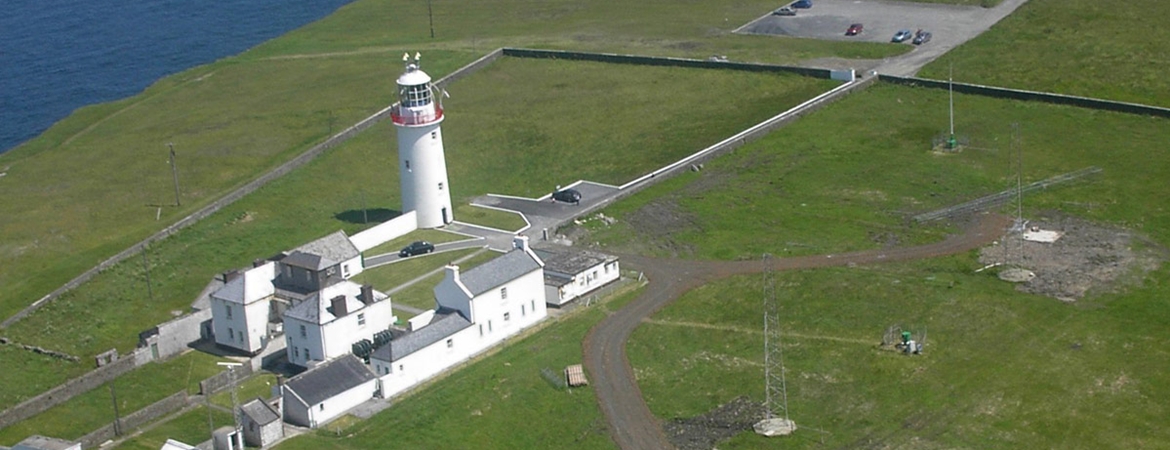The first lighthouse on Loophead was one of four known Irish stone vaulted cottage type lights built about 1670. These cottages accommodated the lightkeeper and his family in two or three rooms and had an internal stone stairway between two of the rooms leading up to a platform on the roof where a coal burning brazier or chauffer was positioned. Part of the old cottage with its battered outside wall can still be seen near the lightkeepers' dwellings.
The light must have fallen into disuse towards the end of the 17th century because it was re-established in 1720 after aldermen and merchants of Limerick petitioned the Irish Parliament in 1717 for a light on the Head.
The cottage-lighthouse with its coal fire was replaced in 1802 by a more conventional lighthouse, built by Thomas Rogers, who was also the contractor. The tower was about the same height as the present tower with four rooms and a lantern. The ground floor room was an oil store and access to the first floor or entrance room by an outside staircase of 19 steps. An internal spiral staircase connected the other two rooms and lantern. The twelve-foot diameter lantern contained twelve oil lamps, each with its own concave parabolic reflector. The reflected light shone through a 22" diameter convex lens of solid glass, not unlike the 'bottle glass' or "bulls-eye" fitted into windows of modern psuedo-Georgian houses.
By 1811 the keeper was living in an adjoining cottage, rather than in the tower.
The number of oil lamps and reflectors in the lantern had been increased to 15 by 1825. During 1836 the Limerick Chamber of Commerce complained of the poor light and went as far as to suggest that the tower should be rebuilt. The Inspector investigated the complaint and reported back to the Board that the light was as good as most lights around the coast and did not warrant immediate attention. However, seven years later, towards the end of 1843, he did propose a new tower and optic. The Ballast Board agreed and by June 1844 the seal was attached to the contract for Mr William Burgess of Limerick to build a new tower, approximately 30 feet from the 1802 tower in an east, north east direction. The new tower, designed by the Inspector George Halpin, was completed early in 1854 and took over from the 1802 tower on 1st May. As the two towers were almost identical in height, the lantern of the old tower had to be completely removed during daylight hours prior to the night of May 1st, so as not to obstruct the new light when it came into operation. The optic was a first order (920mm focal distance) dioptric lens with an oil lamp in its focus giving a fixed or non-flashing light. In September 1866 sanction was given to alter the light from fixed to intermittent. This was achieved by rotating a screen around the lamp and gave a character of twenty seconds light followed by four seconds dark. The screen was rotated by a weight driven clockwork machine. The new intermittent light came into operation in March 1869.
An explosive fog signal was established in 1898 giving one report every ten minutes. This was reduced in 1919 to one every five minutes and reduced again in 1934 to one every four minutes. From May 1971 the fog signal was accompanied by a brilliant flash when sounding in hours of darkness. The explosive fog signal was completely discontinued in 1972.
The light was improved in 1912 by replacing the dioptric lens with its oil lamp and revolving shade with a revolving first order 920mm catadioptric lens giving four flashes every twenty seconds, and the light source was an incandescent vaporised paraffin light using a 50 mm diameter mantle. This was converted to electric in 1971 with 1kW Metal Halide lamps in a UVLA40 lampchanger and the optic is now driven by an electric motor instead of the clockwork rotation machine. The intensity of the light was increased giving a range of 27 nautical miles. The duration of the flash was decreased to 0.1 seconds. The current range is 23 nautical miles.
During 1955 a radiobeacon was established at the station transmitting its morse signal, L.P., every two minutes during fog conditions. A calibration service was also provided on request for shipping. The Radio Beacon was changed to a continual service irrespective of weather in May 1964 and on 8th December 1977 Loophead's radiobeacon was grouped with the new radiobeacon at Slyne Head. In more recent times, utilisation of radio direction finders by mariners has been to a great extent superceded by more modern technology. For this reason the Commissioners discontinued their Medium Frequency Radiobeacon service on 1st February 1999.
At the end of January 1991 the lighthouse was converted to automatic operation and the Keepers were withdrawn from the station. The station is in the care of an Attendant and the aids to navigation are also monitored via a telemetry link from Irish Lights Dun Laoghaire.
A DGPS service transmitting from Loophead, Mizen Head, and Tory Island was introduced in June 1998 and still continues.
The light must have fallen into disuse towards the end of the 17th century because it was re-established in 1720 after aldermen and merchants of Limerick petitioned the Irish Parliament in 1717 for a light on the Head.
The cottage-lighthouse with its coal fire was replaced in 1802 by a more conventional lighthouse, built by Thomas Rogers, who was also the contractor. The tower was about the same height as the present tower with four rooms and a lantern. The ground floor room was an oil store and access to the first floor or entrance room by an outside staircase of 19 steps. An internal spiral staircase connected the other two rooms and lantern. The twelve-foot diameter lantern contained twelve oil lamps, each with its own concave parabolic reflector. The reflected light shone through a 22" diameter convex lens of solid glass, not unlike the 'bottle glass' or "bulls-eye" fitted into windows of modern psuedo-Georgian houses.
By 1811 the keeper was living in an adjoining cottage, rather than in the tower.
The number of oil lamps and reflectors in the lantern had been increased to 15 by 1825. During 1836 the Limerick Chamber of Commerce complained of the poor light and went as far as to suggest that the tower should be rebuilt. The Inspector investigated the complaint and reported back to the Board that the light was as good as most lights around the coast and did not warrant immediate attention. However, seven years later, towards the end of 1843, he did propose a new tower and optic. The Ballast Board agreed and by June 1844 the seal was attached to the contract for Mr William Burgess of Limerick to build a new tower, approximately 30 feet from the 1802 tower in an east, north east direction. The new tower, designed by the Inspector George Halpin, was completed early in 1854 and took over from the 1802 tower on 1st May. As the two towers were almost identical in height, the lantern of the old tower had to be completely removed during daylight hours prior to the night of May 1st, so as not to obstruct the new light when it came into operation. The optic was a first order (920mm focal distance) dioptric lens with an oil lamp in its focus giving a fixed or non-flashing light. In September 1866 sanction was given to alter the light from fixed to intermittent. This was achieved by rotating a screen around the lamp and gave a character of twenty seconds light followed by four seconds dark. The screen was rotated by a weight driven clockwork machine. The new intermittent light came into operation in March 1869.
An explosive fog signal was established in 1898 giving one report every ten minutes. This was reduced in 1919 to one every five minutes and reduced again in 1934 to one every four minutes. From May 1971 the fog signal was accompanied by a brilliant flash when sounding in hours of darkness. The explosive fog signal was completely discontinued in 1972.
The light was improved in 1912 by replacing the dioptric lens with its oil lamp and revolving shade with a revolving first order 920mm catadioptric lens giving four flashes every twenty seconds, and the light source was an incandescent vaporised paraffin light using a 50 mm diameter mantle. This was converted to electric in 1971 with 1kW Metal Halide lamps in a UVLA40 lampchanger and the optic is now driven by an electric motor instead of the clockwork rotation machine. The intensity of the light was increased giving a range of 27 nautical miles. The duration of the flash was decreased to 0.1 seconds. The current range is 23 nautical miles.
During 1955 a radiobeacon was established at the station transmitting its morse signal, L.P., every two minutes during fog conditions. A calibration service was also provided on request for shipping. The Radio Beacon was changed to a continual service irrespective of weather in May 1964 and on 8th December 1977 Loophead's radiobeacon was grouped with the new radiobeacon at Slyne Head. In more recent times, utilisation of radio direction finders by mariners has been to a great extent superceded by more modern technology. For this reason the Commissioners discontinued their Medium Frequency Radiobeacon service on 1st February 1999.
At the end of January 1991 the lighthouse was converted to automatic operation and the Keepers were withdrawn from the station. The station is in the care of an Attendant and the aids to navigation are also monitored via a telemetry link from Irish Lights Dun Laoghaire.
A DGPS service transmitting from Loophead, Mizen Head, and Tory Island was introduced in June 1998 and still continues.





